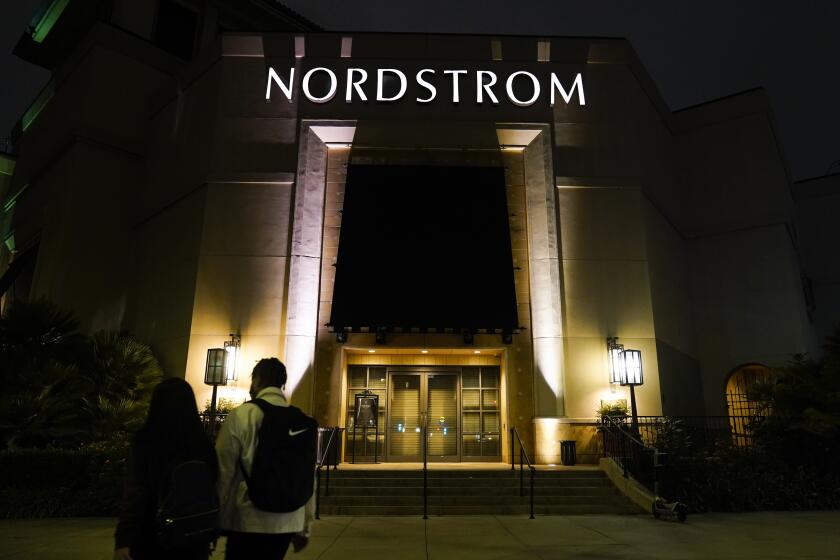Consolidation of Big Defense Contractors May Not Mean Big Savings
When Lockheed Martin Corp. formed two years ago, it became the titan of the aerospace industry, quickly intimidating lesser rivals with its breadth of technology and financial resources.
It has dramatically demonstrated that clout, winning such key programs as the Joint Strike Fighter, expanding its international weapons sales and tightening its grip on the spy satellite market.
The company ranks as the unrivaled leader of the world arms industry, with more than $14.3 billion in sales to the Pentagon in 1996 and an additional $4.8 billion of international aerospace sales.
Lockheed Martin has become the role model that Boeing Co. and Raytheon Co. will attempt to emulate with their recent series of acquisitions meant to add heft to their own aerospace businesses. Boeing is acquiring McDonnell Douglas Corp. and last year bought the defense operations of Rockwell International Corp., while Raytheon is buying Hughes Aircraft and Texas Instruments Inc.
In these recent deals alone, nearly $30 billion is changing hands, yet the net results of the restructuring for the nation remain the subject of sharp debate.
Critics doubt any money will be saved by the mergers, and experts at Rand Corp. have raised concerns that the long-term intellectual vitality of the defense industry may be stunted in the consolidation.
The Clinton administration has encouraged the defense industry to consolidate, hoping to eliminate excess capacity in the industry and reduce cost. Under a major policy initiated in 1994, the Pentagon is preparing to pay out billions of dollars to defense firms to encourage rapid consolidation by offsetting their restructuring costs.
A General Accounting Office report issued recently on these payments raised a number of uncertainties about the claimed savings in defense mergers and noted that some of the costs for dislocated workers are not included in the cost calculations.
The payments have been denounced as “payoffs for layoffs” by Rep. Bernard Sanders (I-Vermont), who recently introduced legislation to end the policy. If the legislation passes, a number of the pending deals may have to be renegotiated, securities analysts say.
“Even if you trusted the motives of the defense industry, which I do not, it would be enormously difficult to determine whether savings have occurred,” Sanders said in an interview. “I have not seen any evidence whatsoever that there have been savings from defense restructuring.”
Both the administration and the defense industry argue that the consolidation will yield enormous savings for taxpayers. Lockheed Martin alone claims it is saving taxpayers $2.7 billion per year, even though the cost of its largest single program, the development of the F-22 jet fighter, has been growing rapidly.
Senior defense officials declined to speak on the record, but in background interviews they pointed to a series of six defense mergers that Pentagon auditors have “certified” as saving $3.95 billion over the next five years. But at the request of the defense industry, the Pentagon has declined to give a breakout of those savings or provide any backup to the claims.
If the industry is cutting its costs, the results are not obvious. In Lockheed’s case, the cost of its largest program, the development of the F-22, has been a persistent problem. The engineering phase of the jet is expected to cost $4 billion more than the original $9 billion announced when the company won the program in the late 1980s. A new Pentagon study last week raised the prospect of even greater overruns that would raise the total cost of the program to $80 billion, up from the previous estimate of $65 billion.
Company executives mainly blame budget cuts by Congress that have stretched out the schedule, a persistent curse in defense programs that overrides whatever reforms and cost cutting have occurred over the years.
Meanwhile, Rand researchers Mark Lorell and Michael Kennedy have studied the consolidation for several years and concluded that reducing competitors in the defense industry threatens to undermine the innovation that has been a hallmark of the military industrial complex since World War II.
The key breakthroughs in defense technology, Lorell and Kennedy say, were achieved by underdogs and second-tier competitors willing to make bold proposals to beat entrenched market leaders.
They cite examples such as the development of the first all-metal mono-wing fighters in World War II, the first combat jets in the 1950s, the first supersonic jets in the 1960s and the first stealth jets in the 1980s. “Every major technological revolution came from the second tier. Now there is no second tier,” Kennedy said.
The U.S. is headed toward a military aircraft industry with just two or three competitors, similar to the structure that existed in the 1930s era, when innovation came to a virtual standstill, Lorell noted.
As World War II ended, Europe had superior aerospace technology, Lorell said. But it entered a drastic consolidation, mirroring what the U.S. is going through now, and it quickly became the inferior industrial power in military aircraft, according to Lorell. At the same time, few of the anticipated savings in the European industry were realized, according to the Rand research.
Steven Kelman, chief of the Clinton administration’s office of federal procurement policy, said the Pentagon has made carefully considered trade-offs between having fewer competitors and attempting to eliminate excess capacity that allows the contractors to operate more efficiently.
“The [Defense Department] has taken a lot of pains to make sure they have at least two competitors in every market,” Kelman said.
International competition is growing stiffer as well, forcing U.S. firms to fight for increasingly important foreign military sales, he said. If U.S. firms do not have the best products and the lowest costs, they will risk losing market share, Kelman said.
Lockheed Martin Chief Executive Norman Augustine believes that the last of the big mergers may finally be at hand. And far from competition growing weaker, Lockheed Martin faces stronger rivals than ever in Boeing and Raytheon.
“They will clearly be much tougher competitors for us,” Augustine said.







